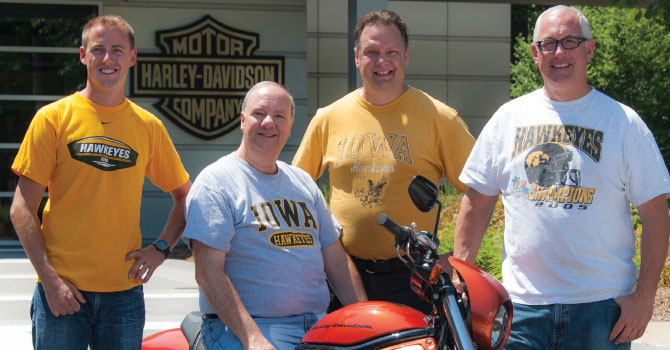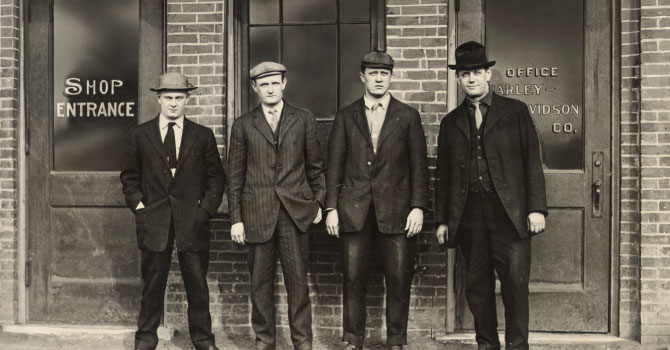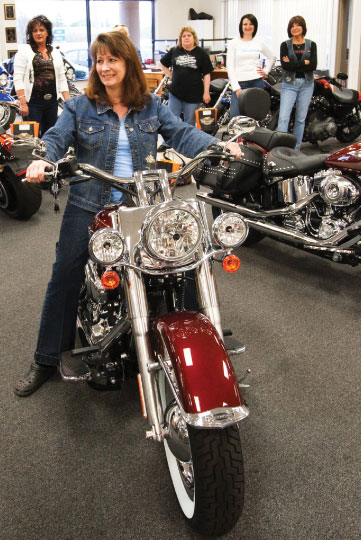The engine vibrates beneath you as your right hand pulls the throttle. Arms braced against the handlebars, chin jutted slightly forward, shoulders set, your stance screams confidence and independence. There’s no mistaking that throaty rumble—this machine is ready to tear up the road. And as the pavement rolls away, as you lean against the buffeting wind, an exhilaration arises that has little to do with transportation. Destination drops out of mind; for now, this stretch of highway, this sun, this view is everywhere you want to be.
That’s the thrill of riding a motorcycle. More specifically, a Harley-Davidson. Because while other companies may sell more units or make more profits than the sole continuously producing U.S.-based motorcycle manufacturer, no company in the world has a stronger lock on the spirit of the product.
“We enable dreams,” says Pete Schmitz, 84MBA, product cost manager for the legendary company. “Freedom and joy. We do that better than just about anybody else.”
 PHOTO: Kelly Riolo/ Kello Photo
The Harley-Davidson company benefits from the executive leadership of Iowa graduates including (left to right) Ryan Dennis, Pete Schmitz, Travis Thatcher, and Scott Beck.
PHOTO: Kelly Riolo/ Kello Photo
The Harley-Davidson company benefits from the executive leadership of Iowa graduates including (left to right) Ryan Dennis, Pete Schmitz, Travis Thatcher, and Scott Beck. Doing so means planning for the future without losing sight of history; capturing new markets without alienating core customers; growing an American icon and making sure it stays relevant, not a relic. And as the company prepares to celebrate its 110th anniversary, it’s being led by a number of top executives who aren’t just Hog owners, they’re Hawks—University of Iowa alumni who have helped bring the company this far, and who are poised to help Harley-Davidson grow even bigger and better.
In 1901, 21-year-old William S. Harley started designing an engine to fit on a bicycle. Two years later, Harley and Arthur Davidson made their first motorcycle for sale—built in a 10-by-15 foot wooden shed with the words “Harley-Davidson Motor Company” written on the door.
 PHOTO: Harley-Davidson Motor CompanyHarley-Davidson's founders, (left to right) Arthur Davidson, Walter Davidson, William Harley, and William Davidson, in the early days of what became an American phenomenon.
PHOTO: Harley-Davidson Motor CompanyHarley-Davidson's founders, (left to right) Arthur Davidson, Walter Davidson, William Harley, and William Davidson, in the early days of what became an American phenomenon. Back then, motorcycles were seen as an affordable means of transportation, much cheaper and more accessible than rare and expensive cars. Today’s “biker culture” wasn’t born until after the Second World War, when returning veterans who had learned to ride (and to love) motorcycles in the service snatched up military surplus machines and formed clubs as a way to enjoy each other’s company—and get their pulses racing.
Mainstream America couldn’t help but notice these leather-clad enthusiasts, some of whom sought independence not only from convention but from the law. The image stuck, reinforced by movies like The Wild One, released in 1953 and starring a swaggering Marlon Brando. The legend of the outsider motorcyclist would be cast and recast over decades—from Easy Rider to The Girl with the Dragon Tattoo. Reinforcing that image and cementing its place in pop culture, numerous rock stars—from Elvis to Wynonna Judd—also adopted the motorcycle as a must-have accessory for their music videos and private lives.
The motorcycle seems to tap into the indomitable, pioneering, adventurous American spirit: think Evel Knievel in his Stars-and-Stripes white leathers soaring across Idaho’s Snake River Canyon on a rocket-powered motorcycle, or Steve McQueen scrambling onto a vintage bike to flee his Nazi captors in The Great Escape.
Elsewhere in American popular culture, the black leather jacket is as much a fashion statement as the little black dress, while many gas tanks flaunt airbrushed masterpieces that range from comic book style to ultra-realism. Motorcycles even transformed the sporting landscape, with racers on dirt roads and on tracks striving to drive farther and faster than ever before. The first rider ever to top 100 mph did so in 1921—on a Harley-Davidson. Since the 1930s, amateur daredevils have flocked to Wall of Death sideshows to test their nerves and riding skills against the laws of physics.
Today, most Harley-Davidson riders come from a range of backgrounds: “Doctors, lawyers, me—a guy in finance,” says Schmitz. He didn’t start riding motorcycles until after he started working for the company. “It’s kind of infectious,” he says. Now, he rides a V-Rod model—even in the rain.
While leading the pack in motorcycle registrations for heavyweight bikes, Harley-Davidson has also made great inroads into diverse markets for young adults, women, and ethnic and racial minorities. That’s no accident, but the product of a carefully targeted multi-generational and multi-cultural marketing strategy.
 PHOTO: Harley-Davidson Motor Company
Through carefully targeted marketing campaigns aimed at women and minority groups, Harley-Davidson hopes to break down some of the stereotypes about motorcycles and their riders.
PHOTO: Harley-Davidson Motor Company
Through carefully targeted marketing campaigns aimed at women and minority groups, Harley-Davidson hopes to break down some of the stereotypes about motorcycles and their riders. Scott Beck was an important part of developing that strategy when he was assigned the Harley-Davidson account as a young advertising rep for a Minneapolis agency. Beck, 85BA, later moved to the company and is now general manager for North America marketing operations.
When he started with the account in the mid-1980s, Harley-Davidson was only beginning to reach out to mainstream consumers. He remembers when the company placed its first ad outside of a motorcycle magazine—in Rolling Stone. Back then, most people thought the typical Harley-Davidson customer seemed edgy—maybe a little dangerous. “The general public would look at those people and say, ‘That is the very epicenter of the free spirit, but maybe I don’t want to look like them,’” Beck says. “The ad campaigns tried to flip the switch, to make them think, ‘Well, maybe I do.’”
Company executives likened the endeavor to building a campfire: if they built it right, it would draw all kinds of people. And it did. Sales soared to a peak of around 300,000 units a year before discretionary spending bottomed out with the global recession of 2008.
Today, the company has a much more fine-grain understanding of its outreach markets. Take female riders. They’d always represented a small segment of the customer base (Bessie Stringfield was only 19 years old when she became the first African-American woman to ride her Harley-Davidson across the country in 1938), but women had been stuck at about 10 percent of the bikes’ ownership for decades.
About 12 year ago, marketers dug in to find what motivates women to ride. Turns out, many of them wanted to escape from the stereotypical soccer mom image or other societal constraints. From there, it was just a matter of translating Harley-Davidson’s core messages—freedom, independence, quality, community—to the targeted audience through initiatives such as “Garage Party” social events at dealerships, how-to videos for female riders, and a line of “pink label” clothing and other products that support breast cancer organizations. As a result, nearly 20 percent of Harley-Davidson owners are now women.
Similar well-researched campaigns help attract African-American and Latino riders. Overall, the company deliberately brings riders into the brand culture; it offers initial free membership to the Harley Owners Group, attends prominent events like Sturgis, Daytona Bike Week, and the X-Games, and hosts its own rallies around the country. Police motorcycle officers receive their own magazine “dedicated to the officers keeping our roadways safe.” Travel-loving riders can even sign up for Harley-Davidson authorized tours that range from weekend getaways to once-in-a-lifetime trips to other continents.
It’s marketing 101, says Gary Russell, Henry B. Tippie Research Professor of Marketing at the UI. Buying a motorcycle is what marketers call a feelings-based purchase. Customers don’t simply acquire a machine; they buy an image. “Either it makes me feel good or I like the way it makes other people look at me,” Russell says. “It’s psychology.”
Without doubt, Harley-Davidson’s customers are passionate owners. Travis Thatcher, 98BA, a senior material cost analyst, likens Harley-Davidson’s brand loyalty to that of the UI: “They’re both very awesome brands that have a huge and loyal following,” he says. Go anywhere wearing an Iowa T-shirt and people are bound to stop you and talk about their black-and-gold roots. The same thing happens with a Harley-Davidson.
"Harley-Davidson is a very unique place. There’s a tremendous amount of pride" - Pete Schmitz
Schmitz recalls when he and his wife were dining at a restaurant and struck up a conversation with a young couple wearing Harley-Davidson garb. When the man found out Schmitz works for the company, he rolled up his sleeve to display a tattoo of the Bar & Shield logo. Schmitz asks: “When’s the last time somebody tattooed Apple or Nike—a company logo—on their body?”
In fact, the brand is so rock-solid that company executives focus more on how to broaden the market than on capturing greater shares of the existing one, Schmitz says. It reminds him of a lesson from his UI days, when a marketing class discussed an advertising campaign for Campbell’s soup.
The commercials simply showed people coming in from the cold to a warm bowl of soup. If offered no specifics about what kind of soup, or claimed that Campbell’s made the best. The argument was that Campbell’s dominated the market so much that it would automatically benefit if people simply ate more soup. Harley-Davidson feels it’s in the same position; if someone decides to try motorcycling, eventually—if not at first—he or she will come around to Harley-Davidson.
Of course, marketing means little without a quality product. When Perry Glassgow, 86BBA, now vice president and controller of Harley-Davidson, started work for the small startup that would become Harley-Davidson Financial Services, the company had come through tumultuous decades battling against cheaper imports and quality control issues.
To keep quality high, employees from the stockroom to the boardroom attend hundreds of events each year. After talking with thousands of customers and potential customers, they take that information back to design teams who incorporate the feedback into new models. When new and casual riders complained the bikes were too heavy or difficult to handle, Harley-Davidson developed models with features like lower-end torque and saddles that allowed riders to put both feet on the ground. When research showed that younger riders thought the trademark chrome was too flashy, the company designed a cool-looking matte black finish. It started producing tricycles for riders who wanted stability but didn’t want to go to the trouble and expense of chopping a standard bike.
At the same time as making these innovations, the company maintained the products that keep its core audience loyal. Customer need even drove Harley-Davidson’s decision to set up its own financial services division, as many banks—perhaps influenced by those biker stereotypes—were reluctant to offer loans. Yet, as Glassgow notes, “Folks don’t want to lose their bike—that’s like losing a lifestyle.”
 PHOTO: Harley-Davidson Motor Company
PHOTO: Harley-Davidson Motor CompanyIn many ways, the company culture mirrors the brand’s image: call the Harley-Davidson corporate switchboard, and the hold music is driving rock. Pull into the parking lot and it’ll be full of bikes—some on loan to employees from a fleet kept just for that purpose. Executives are as likely to wear jeans and leathers as suits and ties. While employees don’t have to ride a Hog to work here, many do so after soaking up the enthusiasm of their coworkers. “Harley-Davidson is a very unique place,” Schmitz says. “There’s a tremendous amount of pride.”
As they open the throttle on the company’s second century, these leaders have their eyes trained on a more distant horizon: the global market. By 2014, foreign markets are expected to account for more than 40 percent of retail sales. Much of that demand is likely driven by the same desire to own an American icon that attracts domestic customers.
“There’s a ton of pent-up demand even in countries where there’s never been a Harley-Davidson,” says Ryan Dennis, 07BA, 07BS, who supported operations for the company in Asia, the Pacific, and Latin America before moving into product development last August. “It’s kind of funny how a brand like Harley-Davidson translates to cultures all over the world.”
Just a few weeks ago, thousands of riders from 66 countries participated in the Harley-Davidson two-day “World Ride” event. Collectively, they racked up 7, 799, 140 miles. Through cities and deserts, across mountain ranges and beside oceans, they united in a celebration of the freedom of the open road. On a gravel-voiced, two-wheeled incarnation of the American dream.

